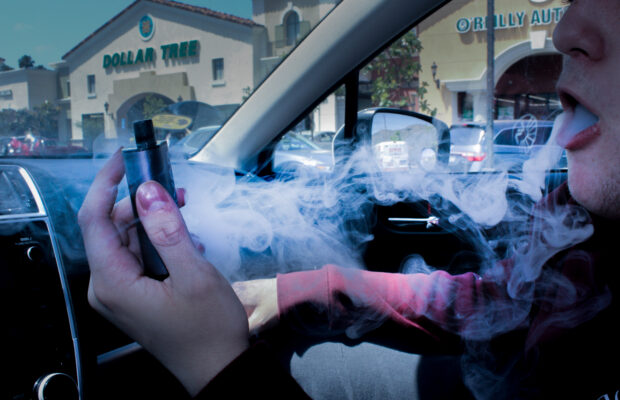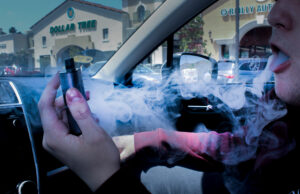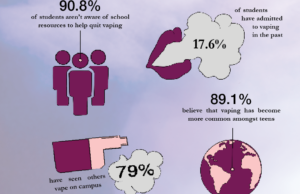The vaping epidemic corrodes teen health

*The graphic on the printed magazine incorrectly stated that 82.4% of students had admitted to vaping, but the actual percent is 17.6%. This change has been reflected in this article and the virtual publication
Vaping products have become vastly popular amongst teens since their production in 2006, and have expanded to appeal to adolescents through appealing flavors and the addictive chemical, nicotine.
In a survey conducted by the NPHS Panther Prowler, 119 responses were collected regarding their experience with vaping and witnessing others vape. Seventy-eight percent (78.6%) of those who responded stated that they have witnessed other students vape on campus, whether that be in the bathrooms, locker rooms or just around the corner of class. According to the CDC, nicotine products can harm adolescent brain development continuously into their mid-20s and can lead to both mental and physical damage to one’s health.
Student Experiences
Despite it being illegal for anyone under the age of 21 to purchase e-cigarettes in California, 54.4 percent of students surveyed who are aware of the vaping epidemic stated that vapes are easy to obtain. Harrison Cosh*, a senior who vapes regularly, says he is able to easily walk into a store or buy a vape from other teens. “There’s also a couple stores or gas stations that if you look old enough [21], or act old enough they overlook and don’t ask you for your ID, or still sell to you,” Cosh said. “Most of the people selling [vaping products] take Venmo and cash and everything gets delivered.”
Students start vaping for many reasons and at various points in their lives, but survey showed that the majority of students are exposed to it in their earlier years of high school. Jamie Stark*, senior, began vaping in sophomore year during a time when she was struggling with her mental health. “Honestly, a lot of kids just do it to be cool. Maybe some just do it to fit in and be cool, but some may have an actual reason,” Stark said.
According to the FDA, nicotine in e-cigarettes can rewire the teen brain to crave more of the substance, and since it is a larger dose, addiction quickly develops. Thus, it is common for those who vape to frequently use their device often. “I vape multiple times a day. It’s always on me, when I go to the bathroom, at work, at my house, even just playing video games, I’ll sit there and hit it,” Cosh said.
This constant use can lead students into developing a strong dependence on nicotine and can feel sickening withdrawals when attempting to stop vaping. Martin Shays*, a senior who has been vaping since freshman year, has attempted to quit several times but has been unsuccessful. “Every time you stop, you feel constantly really crappy and you don’t want to do anything. You kind of lose motivation without it too,” Shays said.
Several students who vape do not hesitate to bring their devices to school, and for students like Shays, it feels more like a necessity rather than an option to vape at school. “It’s pretty difficult not to have my vape at school…because I constantly feel the need to be hitting it in order to feel any sort of relief,” Shays said. By hiding vapes in sleeves, backpacks and pencil pouches, students are able to easily carry a vape around and use them when nobody’s looking. “It’s really easy to hide a vape at school and it’s easy to use a vape in the bathroom. But it’s easy to get caught too, if you’re not being smart,” Cosh said.
According to Michael Godfrey, assistant principal of athletics, if a student is found in possession of a nicotine device, they will first receive a saturday school referral and suspension after the third occurrence. Due to this punishment, Stark (who insisted on being anonymous) is not scared of telling other students that she vapes, but would never tell a teacher or administrator. “With our school, [you would] get in trouble and then they would be like, ‘Oh, do you need help?’, but [you would] get in trouble first. And then I don’t even know if they’d offer help,” Stark said. However, Godfrey reassures that if a student comes to administration to voluntarily turn in a vape and ask for help, he would be there to help them.
CVUSD offers resources for students with alcohol and drug addiction as referenced in the Resources section of this article. These include counseling and student assistance programs such as “Breakthrough.” However, according to the survey done by the Panther Prowler staff, approximately 90.8 percent of students are unaware of any school resources for those who want to quit vaping.
After gaining a dependence on nicotine devices, some students who vape are aware of the damaging effects of vaping but do not believe they will be able to quit. “I noticed my breathing is a little shallower, it can get harder to exert myself walking upstairs,” Cosh said. “People who are inhaling it constantly, similar to me, the lungs kind of get coated in it and it gets detrimental to their health.”
Although some students genuinely enjoy vaping, many also claim that they wish they did not vape, but do not have the power to stop. “I really hate it but being addicted, it’s kind of hard to stop. So the best thing you can do is [to] just not start at all,” Shays said.
*These students were identified with altered names in order to protect their personal privacy.

Medical View of Vaping
All it takes is one try; one try that can change someone’s actions one after another. One choice to try something “new”, sparked by curiosity and intrigued by the selection of fun flavors. And what is thought to be just one, takes a quick turn and leads to another, and then another.
According to the Truth Initiative, vaping sellers are constantly marketing vaping products to appeal to a younger audience, which corresponds with their sudden surge in popularity in 2016. Throughout the past years, countless studies have been done showcasing the harmful effects of vaping.
Various factors come into play as more and more young adults find themselves captured by the addictiveness of vaping products. Dr. Pamela Ling is a certified doctor and researcher on tobacco marketing at the University of California, San Francisco. “For young people, it’s a mixture of curiosity, seeing their friends doing it and curiosity about the flavors. It can seem normal if you have parents that smoke cigarettes or sometimes kids get them from older people in their lives,” Ling said. “If you’re exposed to vapes by seeing someone who is trying to quit smoking, it might seem relatively good. But for a young person who’s never smoked cigarettes or never used nicotine before, then you’re just getting yourself addicted.”
Dr. Janelle Bohl, pediatric doctor at Kaiser, explains the true effects nicotine products take on students. “Nicotine use interferes with attention and learning. A person using nicotine is more likely to have higher levels of anxiety. If you’re becoming dependent on something, you may not be aware of how it’s changing your priorities,” Bohl said. “In my own practice of pediatric medicine, I see changes in the throat, I can tell if they’re vaping by how their throat looks, their nutritional status declines and they’re more susceptible to respiratory infections.”
With vape sales increasing throughout recent years, one brand in particular, JUUL, has been one of the top selling brands in the vaping industry. However, one pod of JUUL contains an equal amount of nicotine as a whole pack of cigarettes. “Even just experimenting with a few JUUL pods can easily get you a lot of nicotine, so vapes are addictive. The arousal, it’s not water vapor, it’s actually a mixture of chemicals and the arousal that comes out of vape has a lot of really fine particles and those can be damaging to the lungs and also damaging to the cardiovascular system,” Ling said.
Although there have been attempts to eliminate the use of e-cigarettes, vendors have found loopholes in regard to what they can sell to the public. “If flavored e-cigarettes were very popular and then a federal law is made saying these flavored e-cigarettes can’t be sold, then the next year the statistics show that menthol flavor, the one that the law didn’t eliminate, then that becomes most accessible and then most used,” Bohl said. “Menthol vapes sales increased because the current FDA policy is not broad enough. Changes in FDA policy can help further reduce access to the loophole products. The tobacco industry finds the loophole and then we see what students are using and it always seems to match the loophole.”
Vaping can leave many feeling desperate for help as they struggle to find guidance with their addiction, but truly there are many outlets for those in need. “You’re not alone, there are thousands of teenagers who are trying to quit vaping. It often takes many tries to quit successfully but if you keep trying you can quit. And don’t try to quit on your own, seek out some help because if you use help it at least doubles your chances of quitting successfully and there are free and confidential supports for teens who are trying to quit vaping so use those supports,” Ling said.
Resources for Students
As vaping continues to impact and influence many high school students, Newbury Park High School and CVUSD have been developing numerous support programs including BreakThrough Student Assistance and the Wellness Center.
The BreakThrough Student Assistance Program works directly with students who are struggling with alcohol, drug usage, social-emotional issues and vaping. Brenda Rachels, a school counselor that works with the BreakThrough Program, collaborates with students and parents to help them through their struggle. “We do interventions by meeting with the students specialized and tailored to what they’re struggling with and really giving them specific coping strategies on how they can [manage] stress and life,” Rachels said.
Similar to the BreakThrough Program, the Wellness Center is a resource on campus that not only has therapists who provide student tailored assistance in the process of overcoming addiction, but also serves as a therapeutic area for students to access during the school day. Page Pensivy, a Professional Clinical Counselor at the Wellness Center, works to help students with their addiction. “We focus on putting little steps into place, maybe getting them connected with a 12-step program or Breakthrough outside of school, or going through administration if that’s something they’re comfortable with,” Pensivy said.
At NPHS, students who voluntarily turn in a vape or seek for help are not faced with punishments but instead are provided with both in school and external assistance. “They’re not going to get in trouble [and] we’re not here to bust people. So if anybody’s actually reaching out to an adult here on campus, we’re going to do everything we can to get them help without having some sort of consequence,” Godfrey said. However, if the student fails to ask for help and are caught vaping by admin, they will be subject to Saturday School the first two times, and a suspension the third time.
Brian Mercer, the director of the high schools in CVUSD, designed educational disciplines to make sure the students are properly educated on vaping. “Students will need to complete these modules and each module can consist of an educational video or a discussion,” Mercer said. “Students read and report back so they’re becoming educated about the dangers of vaping and how it affects them and their health.”
Ever since the educational modules were put into place, the amount of students who have been caught vaping for a second time has gone down significantly. However, upon reentering from a disciplinary action, students are scheduled to attend a meeting with school admin and therapists at the Wellness Center. “We provide counseling for them in hopes that there’s something that comes out of it,” Pensivy said.
Whether it be vaping or anything else that students may be struggling with, Godfrey shares a message in hopes for students to overcome the challenges of addiction. “Ask for help, whether it’s from a friend or parent. Nobody wants to be addicted to anything and it’s not a way to go through life. Just know that help is out there and if you can find a way to get a vape, you can find a way to get help too,” Godfrey said.



